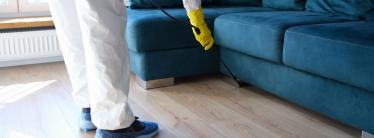
Are landlords responsible for pest control?

Pests such as mice, rats, cockroaches, and flies pose health and safety risks. Infestations should be dealt with promptly. However, it's not always immediately obvious who's responsible for dealing with them.
Let's explore landlords' and tenants' legal obligations and best practice preventative measures when dealing with pests.
Legal responsibilities of landlords towards pests
Landlords in the UK have legal responsibilities when it comes to dealing with pest infestations in their rental properties. The specific requirements vary by region, but there are some common obligations.
The regulations governing pest infestation rules across the UK are:
- England: The Housing Act 2004 (external link) and the Environmental Protection Act 1990 (external link) outline landlord pest control duties in England.
- Wales: The Renting Homes (Fitness for Human Habitation) 2022 (external link) and the Environmental Protection Act 1990 (external link) outline landlord pest control duties in Wales.
- Scotland: The Housing (Scotland) Act 2006 (external link) and the Environmental Protection Act 1990 (external link) govern landlord pest control responsibilities in Scotland.
- Northern Ireland: The Private Tenancies Order 2006 (external link) outlines landlord responsibilities in Northern Ireland.
Each region establishes specific guidelines for pest control responsibilities.
Landlords must ensure their properties are in a "good and habitable state".1 (external link) If pest infestations appear because of an issue with your rental property, such as if it's fallen into disrepair, you may be responsible for dealing with them.
Landlords are typically responsible for dealing with infestations if:
- The tenancy agreement specifically states that the landlord is responsible for pest control or includes language about keeping the property in a "good and habitable condition".
- The infestations occurred because the landlord didn't make necessary repairs – for example, if pests entered through holes in walls.2 (external link)
The landlord might also be responsible if the pest infestations make their property unfit to live in – for example, rats pose health and safety risks and can cause illnesses.
If in doubt, there might be a clause in your tenancy agreement stating whether you're responsible for dealing with pest infestations. 44% of tenancy agreements include one.3 (external link)
Sometimes, infestations are neither the landlord's nor the tenant's fault. For example, according to the NRLA (external link), the fourth-most common cause of infestations is pests migrating from neighbouring properties.
If landlords do not fix pest infestations, tenants can contact environmental health (external link). The council (external link) can make landlords fix pest issues.
Tenants might also be eligible for compensation (external link).
Disclaimer:
Managing rental properties is a complex business. At Hiscox, we want to see your investments thrive. Our articles offer insights into property management and landlord best practices. But these articles aren't professional advice. To find out more about a subject we cover here, please seek professional advice.
Common pests in rental properties
A recent poll by NRLA (external link) found that the most common pest infestations are:
- Mice (47%)
- Rats (39%)
- Insects (26%)
- Wasps (14%)
- Fleas (12%)
- Bed bugs (11%)
- Cockroaches (85%).
Landlords are advised to seek professional advice (external link) if they're unsure which animals they can trap and kill.
The British Pest Control Association (BPCA) (external link) lists what you're allowed to use to control pests.
Preventative measures
There are various measures landlords can take to reduce the risk of pest infestations and maintain a healthy, pest-free environment for their tenants.
Routine inspections
- Regularly inspect potential pest entry points, such as cracks, gaps, and holes in walls, windows, and doors.
- Check for signs of pests, such as droppings, nests, or damage to property.
- Ensure tenants are properly disposing of waste and keeping the property clean and tidy.
If you identify any issues, you should schedule necessary repairs promptly to fix damp or mould problems and repair holes in walls.
Tenant education
- Provide information on preventing pest infestations, including cleanliness and waste disposal tips.
- Ensure tenants are aware of their responsibilities as outlined in the tenancy agreement.
Responding promptly to tenant reports of pest sightings can help you address issues before they become more serious.
Tenant responsibilities
Tenants are legally obliged to act in a "tenant-like manner".4 (external link) This includes keeping the property clean and tidy, such as storing food and disposing of waste properly to avoid attracting pests.
The Housing Ombudsman (external link) recommends that tenants report potential infestations to their landlords immediately.
The National Residential Landlord Association (NRLA) (external link) identifies a 'dirty environment' as the top cause of infestations. You may be able to deduct the cost of removing pest infestations from the tenant's deposit if you prove that your tenant caused the infestation.
Handling pest infestations
The Housing Ombudsman (external link) outlines various steps for landlords handling pest infestations.
Best practices include the following:
- Respond in a timely manner to pest infestation reports, acknowledging the issue
- Arrange an inspection to assess the report
- Clearly communicate how you're addressing the infestation to tenants
- Find out if your local council (external link) provides pest control services or hire a licensed pest controller (external link) to treat the infestation promptly
- Advise local authorities, such as environmental health teams, if the infestation affects wider areas
- Conduct regular inspections to ensure the issue is resolved.
The Housing Ombudsman (external link) states that landlords should not make the tenant fix the problem. If the landlord believes that tenant negligence has contributed to the issue, they should help the tenant address it.5 (external link)
Cost and financial considerations
Professional pest control costs vary depending on factors such as property size and severity of the problem.
Some landlords allocate an annual maintenance budget that includes pest control.
Conducting regular property inspections to catch issues early can minimise the risk of more serious, costly repairs later.
Investing in preventative measures, such as sealing entry points and installing covers on vents, can be cost-effective in the long run. However, handling pest control yourself can be counterproductive. Improper handling can lead to more extensive and expensive problems. Landlords are advised to use professional pest controllers or contact the council.
Depending on the size and severity of the infestation, dealing with infestations can be costly.
Some landlords insurance policies cover the cost of removals. For example, Hiscox landlords buildings insurance covers the removal of nests as standard, with a limit of up to £2,000 per claim for nest removal costs.
References
- https://www.gov.uk/private-renting
- https://www.citizensadvice.org.uk/housing/repairs-and-housing/repairs-and-housing-conditions/common-problems/repairs-infestations-of-pests-and-vermin/
- https://www.nrla.org.uk/news/new-poll-by-tenancy-deposit-scheme-reveals-common-pest-issues-faced-by-landlords
- https://www.nrla.org.uk/resources/looking-after-your-property/tenants-repair-responsibilities
- https://www.housing-ombudsman.org.uk/centre-for-learning/key-topics/pests/pest-guidance/






